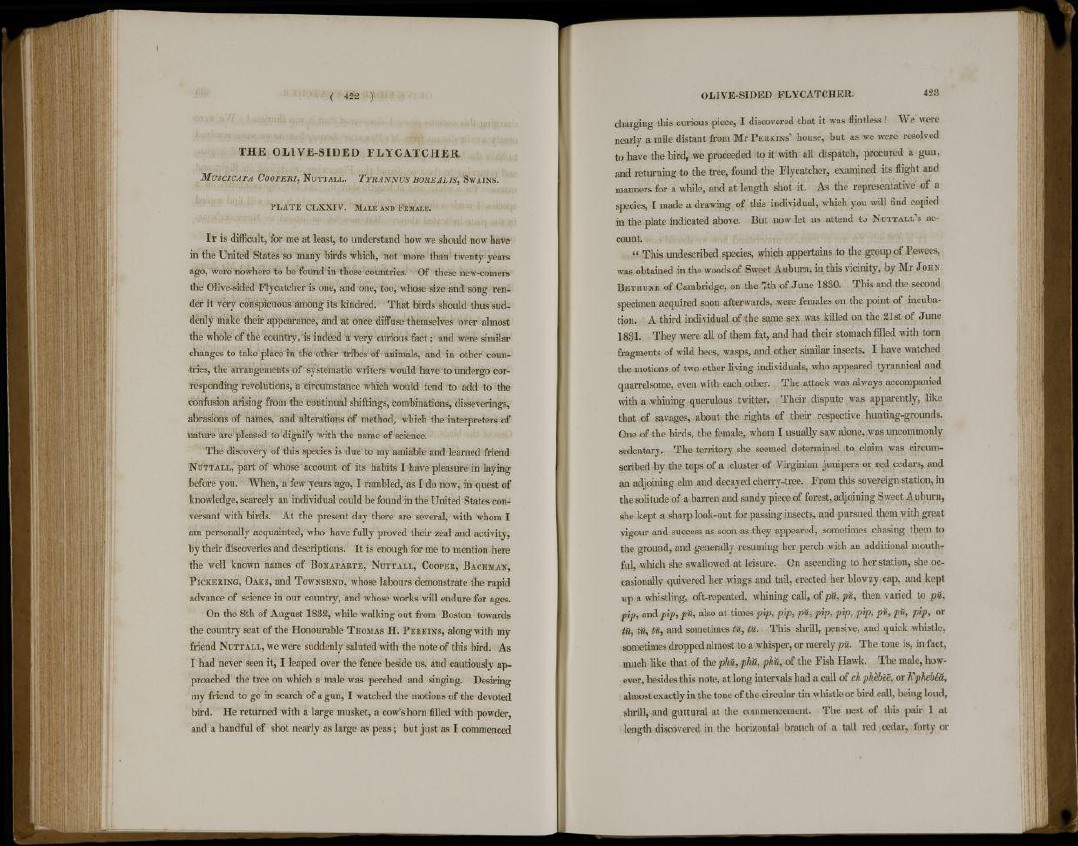
T H E O L I V E - S I D E D F L Y C A T C H E R .
MUSCÍCAPA COOPERI, NUTTALL. TYRANNUS BOREALIS, SWAINS.
P L A T E C L X X I V . MALE AND FEMALE.
IT is difficult, for me at least, to understand how we should now have
in the United States so many birds which, not more than twenty years
ago, were nowhere to be found in those countries. Of these new-comers
the Olive-sided Flycatcher is one, and one, too, whose size and song render
it very conspicuous among its kindred. That birds should thus suddenly
make their appearance, and at once diffuse themselves over almost
the whole of the country, is indeed a very curious fact; and were similar
changes to take place in the other tribes of animals, and in other countries,
the arrangements of systematic writers would have to undergo corresponding
revolutions, a circumstance which would tend to add to the
confusion arising from the continual shiftings, combinations, disseverings,
abrasions of names, and alterations of method, which the interpreters of
nature are pleased to dignify with the name of science.
The discovery of this species is due to my amiable and learned friend
NUTTALL, part of whose account of its habits I have pleasure in laying
before you. When, a few years ago, I rambled, as I do now, in quest of
knowledge, scarcely an individual could be found in the United States conversant
with birds. At the present day there are several, with whom I
am personally acquainted, who have fully proved their zeal and activity,
by their discoveries and descriptions. It is enough for me to mention here
the well known names of BONAPARTE, NUTTALL, Coor-ER, BACHMAN,
PICKERING, OAKS, and TOWNSEND, whose labours demonstrate the rapid
advance of science in our country, and whose works will endure for ages.
On the 8th of August 1832, while walking out from Boston towards
the country seat of the Honourable THOMAS H. PERKINS, along with my
friend NUTTALL, we were suddenly saluted with the note of this bird. As
I had never seen it, I leaped over the fence beside us, and cautiously approached
the tree on which a male was perched and singing. Desiring
my friend to go in search of a gun, I watched the motions of the devoted
bird. He returned with a large musket, a cow's horn filled with powder,
and a handful of shot nearly as large as peas; but just as I commenced
charging this curious piece, I discovered that it was flintless ! We were
nearly a mile distant from Mr PERKINS1 house, but as we were resolved
to have the bird, we proceeded to it with all dispatch, procured a gun,
and returning to the tree, found the Flycatcher, examined its flight and
manners for a while, and at length shot it. As the representative of a
species, I made a drawing of this individual, which you will find copied
in the plate indicated above. But now let us attend to NUTTALL1 s account.
" This undescribed species, which appertains to the group of Pewees,
was obtained in the woods of Sweet Auburn, in this vicinity, by Mr JOHN
BETHUNE of Cambridge, on the 7th of June 1830. This and the second
specimen acquired soon afterwards, were females on the point of incubation.
A third individual of the same sex was killed on the 21st of June
1831. They were all of them fat, and had their stomach filled with torn
fragments of wild bees, wasps, and other similar insects. I have watched
the motions of two other living individuals, who appeared tyrannical and
quarrelsome, even with each other. The attack was always accompanied
with a whining querulous twitter. Their dispute was apparently, like
that of savages, about the rights of their respective hunting-grounds.
One of the birds, the female, whom I usually saw alone, was uncommonly
sedentary. The territory she seemed determined to claim was circumscribed
by the tops of a cluster of Virginian junipers or red cedars, and
an adjoining elm and decayed cherry-tree. From tins sovereign station, in
the solitude of a barren and sandy piece of forest, adjoining Sweet A uburn,
she kept a sharp look-out for passing insects, and pursued them with great
vigour and success as soon as they appeared, sometimes chasing them to
the ground, and generally resuming her perch with an additional mouthful,
which she swallowed at leisure. On ascending to her station, she occasionally
quivered her wings and tail, erected her blowzy cap, and kept
up a whistling, oft-repeated, whining call, of pu, pu, then varied to pit,
pip, and pip, pu, also at times pip, pip, pu, pip, pip, pip, pu, pu, pip, or
tu, tu, tii, and sometimes tu, tu. This shrill, pensive, and quick whistle,
sometimes dropped almost to a whisper, or merely pu. The tone is, in fact,
much like that of the phu, phu, phu, of the Fish Hawk. The male, however,
besides this note, at long intervals had a call of eh phebee, or Kpliebka,
almost exactly in the tone of the circular tin whistle or bird call, being loud,
shrill, and guttural at the commencement. The nest of this pair 1 at
length discovered in the horizontal branch of a tall red cedar, forty or